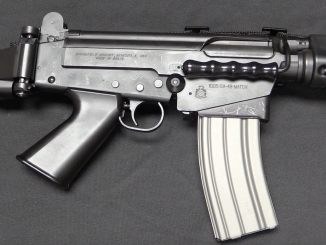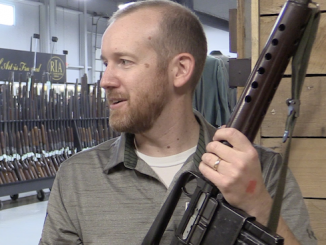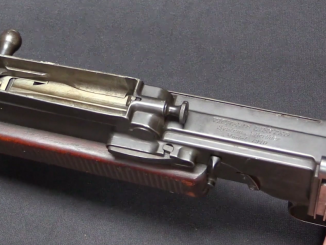The 1883 Colt-Burgess was the Colt company’s single, brief endeavor to enter the lever action “cowboy” rifle market. Winchester had been making some moves to break into Colt’s lucrative shotgun and pistol markets, and Colt reacted by hiring noted gun designer Andrew Burgess to design them a rifle to compete with the Winchester 1873.
Only about 6400 of these were made (in both rifle and carbine configurations) before Colt and Winchester executives got together and negotiated a deal to stay out of each others’ areas of specialty. As a result, Colt stopped manufacturing the 1883 Colt-Burgess rifle, and Winchester stopped developing (and importing) revolvers. Because of its short production span, the Burgess remains a particularly rare lever action rifle today. For folks who are interested in shooting one without investing the money to own and original, reproductions are available today from Uberti.




I may be wrong, but wasn’t Turkey still a part of the Ottoman Empire in the 1880s? (I’ve only taken one history class that covered some of the middle east and it ended with the siege of Constantinople, so I don’t know much of what happened afterward other than western colonization.)
The Ottoman empire did not fall until the 1920s. The Anatolian area, which makes up most of modern Turkey, was the heart of the empire.
My recollection of the Winchester/Colt story is that after Colt started to produce the Burgess rifle Winchester designer William Mason was tasked with designing a revolver. Winchester then took prototypes to show Colt the result was that that both companies agreed to stay out of each others businesses. I remember reading this in the late 1950s or early 60s. I believe the prototypes were in the Winchester Muesum.
Trivia note; at least one of the prototype revolvers Winchester had was designed by Hugo Borchardt, whose later automatic pistol design was the basis for the Parabellum pistol designed by Georg Luger.
I’d been unaware of the Winchester Turkish revolver contract, but it’s not surprising since Winchester was a major supplier of rifles to the Turkish Army during the Russo-Turkish War.
The Turks used Winchester repeaters in .44 rimfire for massed close-range fire to destroy Russian “human wave” infantry assaults on entrenchments, notably at the siege of Plevna. It was an eerie foreshadowing of Flanders, not to mention Iwo Jima, Korea, and Vietnam.
According to History of Winchester Firearms, the revolver design was the work of William Wetmore, formerly of Smith & Wesson. Shown on p.52-53, it resembles the Merwin & Hulburt, and apparently had a swing-out cylinder similar to the 1866 William Mason patent used by Remington on some of their “cartridge conversion” revolvers in the late 1860s through the 1880s;
http://books.google.com/books?id=dZmlpZivhU8C&pg=PA53&lpg=PA53&dq=winchester+turkish+contract+revolver&source=bl&ots=H3V0horci9&sig=O1ThUyOsOsX9kMTFFLAKJHFQ-Gk&hl=en&sa=X&ei=MWR3VMaJCKqIsQTBqIGoCw&ved=0CDYQ6AEwBA#v=onepage&q=winchester%20turkish%20contract%20revolver&f=false
Mason of course was the main designer of the Colt Model P (1873 aka “Peacemaker”), and was working for Winchester at the time of the “Meeting of Minds” between Colt and Winchester on who made what. According to the Winchester book, he was mostly responsible for refining John Browning’s designs for mass production, notably the Model 1886 rifle (the direct ancestor of the Model 1894 “thirty-thirty”), and the Model 1893/97 pump-action shotgun.
Well, that’s their story, anyway. Nobody else seemed to think Browning’s designs needed anyone else to “refine” them. Notably Colt.
cheers
eon
I don’t know if it’s really appropriate to call the Russian tactics in the Russo-Turkish War “human waves”. Attacks in closed formations were still pretty much standard for the day, although more modern infantry tactics had been tried during the final years of the American Civil War. Still, it wasn’t until WW1 when it was fully realized that they wouldn’t work any more even if the attacker had a large numerical superiority.
On the other hand, in Korea and Vietnam the Chinese and North Vietnamese (respectively) commanders knew full well that human waves would result in large casualties and used them anyway, since they were pretty much the only tactics available during daylight hours for their armor and artillery poor forces on open ground, where flanking maneuvers were not possible. During the dark hours infiltration was used very well to compensate as much as possible.
Some of the Japanese counter-attacks during the PAcific island campaigns really were human waves (“banzai” charges), but Iwo Jima is a very poor example of that. The Japanese commander, General Kuribayashi explicitly forbade counter-attacks and only allowed one at the end when the Japanese were running very low on supplies anyway. Even that attack was not a typical “banzai” charge but instead the Japanese tried to get silently as close to the US position as possible at night. Earlier at one occasion Kuribayashi’s orders were not followed and that led to the only massed Japanese counter-attack of the battle, with predictable results.
The Battle of Saipan would be a very good example of Japanese human waves in WW2. There and in many other cases the Japanese “banzai” charge was a desperate last resort, more a way of ritual mass suicide than legitimate military tactics. This was different from the later Chinese and North Vietnamese human waves, which were calculated use of their numerical superiority against the UN/US superiority in firepower.
edit: should be:
I’ve search for patent for this fire-arm and i find: this is US Patent US 340479 A available here: http://www.google.com/patents/US340479 but when I clicked in “Inventor: Andrew Burgess” I found that he patent not only lever-action design, but also automatic fire-arms namely patents:
US821922A from 1906 “AUTOMATIC GUN”
US693106A from 1902 “AUTOMATIC GUN”
US726399A from 1903 “GAS-OPERATED FIREARM”
US822851A from 1906 “AUTOMATIC GUN”
US636196A from 1899 “AUTOMATIC GUN”
US666084A from 1901 “AUTOMATIC GUN”
US687448A from 1901 “AUTOMATIC GUN”
US520752A from 1894 “RECOIL-OPERATED FIREARM”
US663956A from 1900 “AUTOMATIC FIREARM”
US591525A from 1897 “RECOIL-OPERATED FIREARM”
US589120A from 1897 “GAS-OPERATED FIREARM”
US693105A from 1900 “AUTOMATIC GUN”
US663955A from 1900 “AUTOMATIC FIREARM”
US715971A from 1902 “AUTOMATIC GUN”
US520753A from 1894 “RECOIL-OPERATED GUN”
US821921A from 1906 “AUTOMATIC MAGAZINE-GUN”
US663954A from 1900 “AUTOMATIC FIREAM”
US589118A from 1897 “AUTOMATIC MAGAZINE FIREARM”
Do anybody of you know that one of before-mentioned designs reach prototype state? Did A.Burgess build prototypes before patenting or there are only patent without real fire-arms?
According to the image at “www.gunsandammo.com/ga-vault/borchardt-revolver/” the Hugo Borchardt designed Winchester revolver seems;
– Single Action,
– Solid frame with a swinging out cylinder to the right,
– Cylinder center pin with a knurled larger diameter section to be drawn front to
unlock,
– Cylinder locked at barrel underlug at front, frame frontface in front of crane arm and possibly recoil plate at rear,
– Cylinder center pin pushing extraction.
No doubt regular readers and viewers will know what you meant, but at 5:17 you state “Colt would stick to making rifles, and Winchester could stick to making pistols.” Of course, it was the other way around.